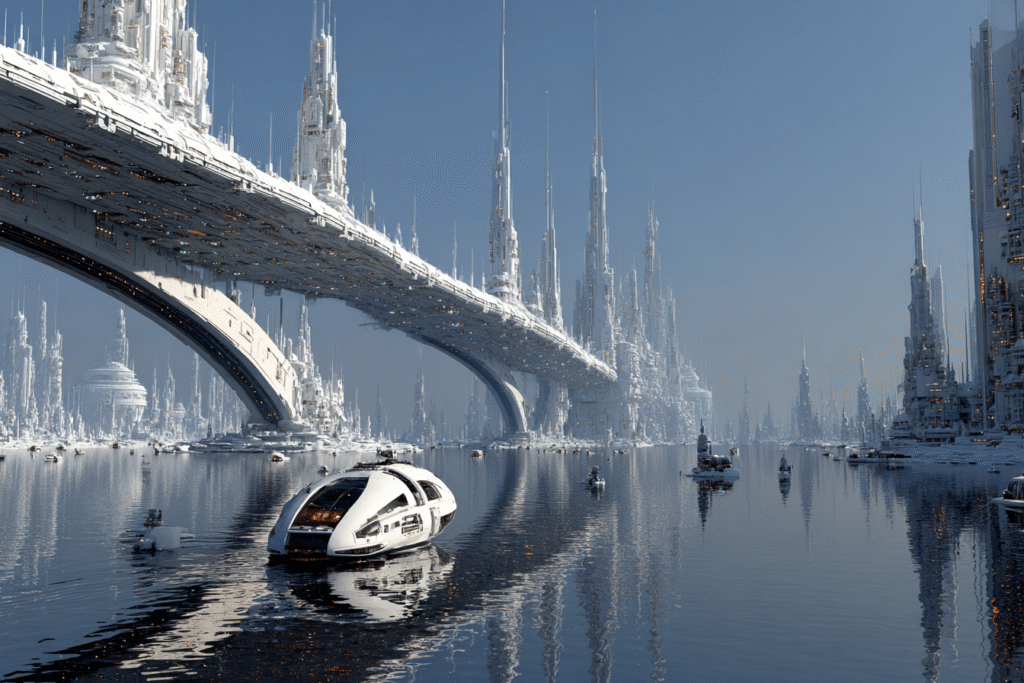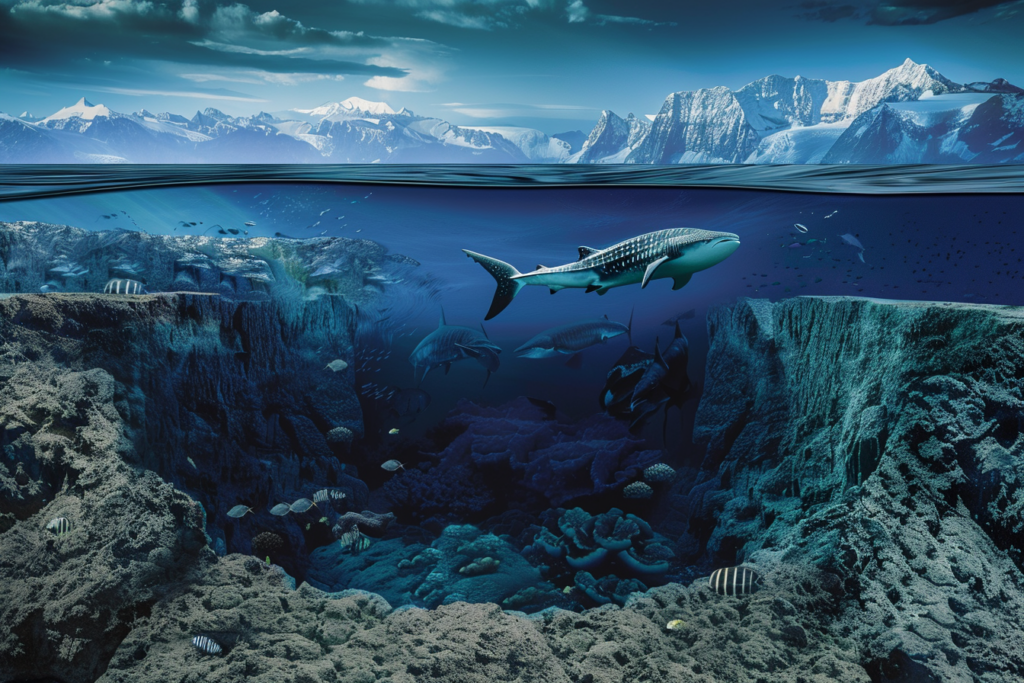
From SRP author Cameron Cooper:
I love seeing concepts for cities of the future. I love seeing how people might live and work and go about their everyday lives. I like seeing how technology changes the way we might live.
For example: I really liked the Star Trek: Beyond movie (I ignore the fact that they jump to light speed without a deflector shield). What I *really* like about that movie is Starbase Yorktown. I love the place. I would live there, if it existed. I have slowed down and paused the movie just to study some of the overhead and wide shots of Yorktown. It’s a fantastic future city. (And for copyright reasons, including the a-hats who “bill” anyone who posts an image from movies, these days, I can’t include an image of Yorktown here. Search on Google Images — it’s a jaw-dropping sight!)
There are concept illustrations for the inside of O’Neill cylinders that I find super interesting to study. (And I transplanted one right into the Iron Hammer series and called it Winchester.) Apparently Jeff Bezos wants to build one for real, too.

NASA/Donald Davis – NASA Ames Research Center https://space.nss.org/settlement/nasa/70sArtHiRes/70sArt/art.html Description at artist’s web site http://www.donaldedavis.com/PARTS/SHORTBIO.html Island Three cylindrical space habitat, “Endcap view with suspension bridge”.
I also really like the idea of vertical villages: high-density, mixed-use developments that blend residential areas with communal spaces like farms, schools, and shops, aiming to create a strong sense of community and “social density” within a single vertical structure. Given all the empty high rises in our cities, that seems like a great recycling project to me. I’m already seeing this happening in my city; high-rise or multi-story apartment blocks are starting to feature coffee shops and other retail stores on the ground floor. Imagine a tall building that has levels of retail every fifth story, plus levels for farms (hydroponic or not), hospitals, and all the other infrastructure that sustains a neighbourhood.
Another future city concept that I was exposed to early in my SF reading days was Robert Heinlein’s concept of automated roads – you hop onto them, usually in a self-propelling vehicle of some sort, and they race you along at unbelievable speeds until the computer spits you out at your pre-programmed stop.
The idea crops up in a lot of his novels and stories, along with the subsidiary consequences: Strip cities that build themselves all the way along the rolling roads.
The highway between Edmonton and Calgary, the Queen Elizabeth II (QEII) is one of the most heavily trafficked highways in Canada. I think only a stretch of highway near Toronto gets more traffic. And driving to Calgary can be a fraught exercise because no one goes at the speed liimit except nervous drivers who clog up the lanes for everyone else. Traffic is bumper to bumper, too. You can’t afford to relax or lose focus…for three hours.

You can fly between the two cities; but it only takes three hours to drive, while flying takes an hour, plus 90 minute to wait before boarding, plus getting to the airports which are – ironically – miles outside the city limits of both cities, each just off the QEII; so you’re thirty minutes closer to your destination just getting to the airport.
Plus the price of airline tickets rises and falls according to the season. I tried to get a seat on a plane for my daughter, one Christmas. Each seat was $1,200 CAD. I ended up clearing off a day and driving to Calgary and back to fetch her. The price was less than a full tank of gas.
Once, my husband flew in from the Austin Film Festival, but his flight stopped at Calgary before doing the little spike and drop to Edmonton. As he took off from Austin, he got notice that his flight to Edmonton had been delayed by four hours.
I jumped in the car and drove to Calgary to pick him up from the Calgary airport when he arrived (so I didn’t even get into the city limits), and we drove back to Edmonton, to arrive before his flight to Edmonton took off.

I’ve often thought that Robert Heinline’s rolling roads would work perfectly, between Calgary and Edmonton. Or, alternatively, a high speed train like they have in France or Japan. One that does the trip in 20 minutes. I could see people living in Calgary and commuting to Edmonton for their day job and vice versa.
So when I heard about the new super-highspeed pod train that will be built here in Edmonton, my interest spiked. Hard. There is a company, Transpod, who build ultra-high-speed “transpods” – they’re not exactly trains, because they are suspended from an overhead track, and completely enclosed in a clear tunnel that reduces wind resistance.
I have a few photos on this page, but you should click over to the Transpod site to see the videos.
It really does look as though the line will go ahead, which for me is very exciting. I have to wonder how this will change life for Calgarians and Edmontonians. Will people start to commute between the cities on a daily basis? Red Deer, the city that is nearly exactly half-way between Calgary and Edmonton; how will that fare, with fast transport to the other two? Will Edmontonians choose to work in Red Deer, or Red Deer residents work in Edmonton or Calgary?
What sort of support services will spring up as a result?

Will the domestic flights between Edmonton and Calgary cease? They’ve been troubled, overly expensive and time-consuming since 9/11; this might be the death knell.
How much will the culture of the two (three) cities mesh and merge? When international performers and bands choose to only play at one of the cities (which happens with tiresome frequency), fans in the other cities could hop on the transpod to catch the concert and still sleep in their own beds that night.
Very fast transport, if it is cheap enough, will change a lot of aspects of living in Alberta. I’m sure that there will be even more unanticipated consequences that come out of it. Sort of like how cellphones have become the modern historians’ original sources of documentation. Or, go back further in history, how drive-ins became the way rural regions saw recent movies, because the car was invented and adopted widely.
It will absolutely boost the economy, and the tourism industry.
And if it proves itself, more transpod lines will be built; imagine one connecting Los Angeles with New York. Or Perth and Sydney. Imagine a transpod doing a circuit around Europe, or running the length of the Americas. Breakfast in Winnipeg, lunch in Oaxaca or Guatemala City, and dinner in Puerto Williams, with a view of the Southern Ocean.
The shape of our cities — and how we move between them — has always evolved with our technology. But every now and then, a leap forward hints at a different kind of future entirely. Maybe one day, we really will glide between floating arcologies or hop pods from continent to continent like subway stops. Until then, I’ll be watching the skies, the sketches, and the startup news, wondering which vision will come true first — and quietly hoping for an O’Neill cylinder with a good bookstore.

Cameron Cooper
SRP Author
Check Cam’s books here on Stories Rule Press.



